While walking through the aisles of the Toronto International Art Fair last October something very strong and large with bright, burning red colors caught my eye. I thought, “Wow, isn’t it a bit too much?” and kept walking but somehow after passing three more booths, I went back. There was something intriguing about that painting. It turned out to be Steve Driscoll’s “Seared by the Sun,” depicting a landscape set on fire by the setting sun.
When I learned that Angell Gallery had dedicated a solo show to Driscoll’s recent paintings, I was happy to have a chance to see more. Steve Driscoll, however young, is a well-known artist with many exhibitions to his credit and a few, but important publications about his persona and work: “Conversations” with 15 interviews (2008) and “Intelligence with the Earth,” a book by Gary Michael Dault (2012), among them.
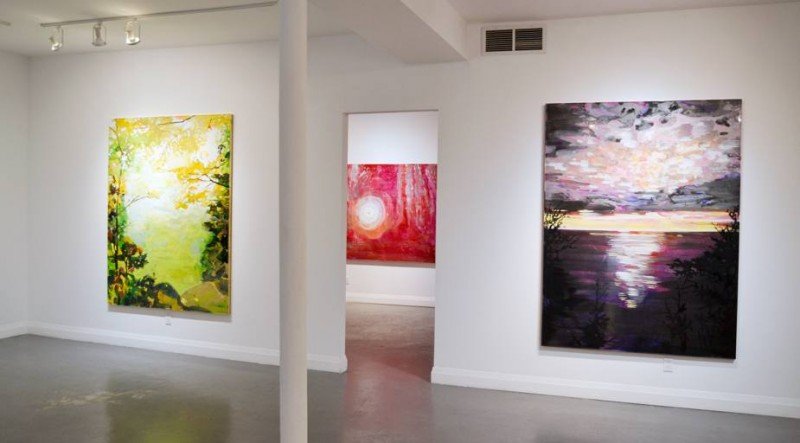 Steve Driscoll, The Smoke Show and Other Deceptions in Paint, 2015. Installation view. Photo: Marco Bertuzzo. Courtesy of Angell Gallery
Steve Driscoll, The Smoke Show and Other Deceptions in Paint, 2015. Installation view. Photo: Marco Bertuzzo. Courtesy of Angell Gallery
His current exhibition, The Smoke Show and Other Deceptions in Paint, consists entirely of landscapes. When talking about Canadian art with Europeans, landscape comes up first and they think that landscapes are all that Canadian artists do. Everyone knows about the Group of Seven and they truly believe that landscapes represents the Canadian identity best. They envy our endless forests and countless lakes — the infinity of our still wild lands. They know little about the contemporary culture that is slowly building here, even in the landscape genre; the tension-filled fields of Alex Colville, Peter Doig’s semi-abstract lakes, Kim Dorland’s neon-bright paintings and Steve Driscoll’s work.
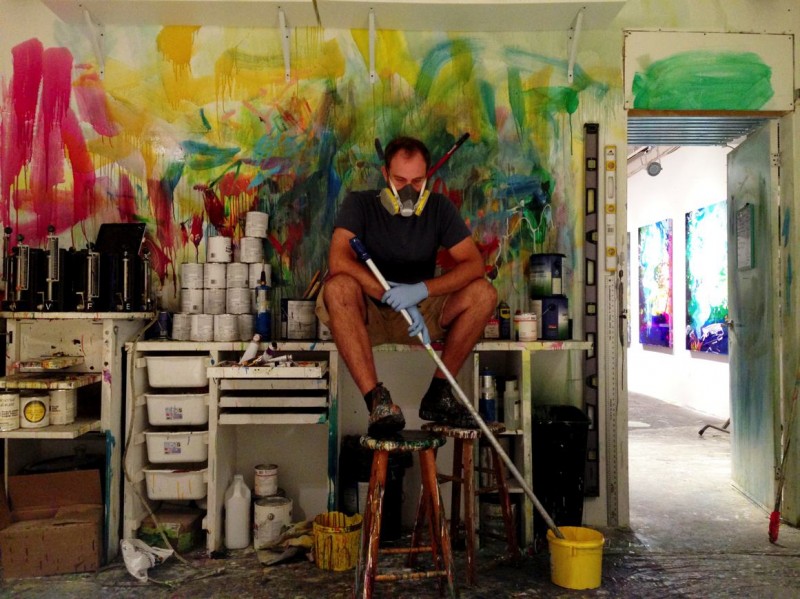 Steve Discoll in his studio, 2014. Photo: Mike Shore. Courtesy of the artist
Steve Discoll in his studio, 2014. Photo: Mike Shore. Courtesy of the artist
The Smoke Show series captures the smoke of a campfire, something unusual as the theme for paintings. Driscoll says that he is most interested in the process within his work. Every new show starts with experimentation in his studio and when he comes across a new way to manipulate a material or set of colours, he will look to nature to see where it can be applied. He uses the industrial material urethane that permits a watercolor-like translucency. Smoke Show series is a perfect example of this method, as he describes, “ I developed a process which leaves a ghost-like mark on the surface. Rather than covering the paint beneath, it takes the colours from below and shifts their tone in a direction of my choosing. Not immediately knowing what to do with this I started to explore my surroundings and came across campfire smoke… I wanted there to be a meditative element which mimicked the effects of watching smoke rise into the night. Although the exact locations of my work are rarely important to me, this fire was at the turn-around point of a 100k hiking trail, which meant I was in a very contemplative state of mind.”
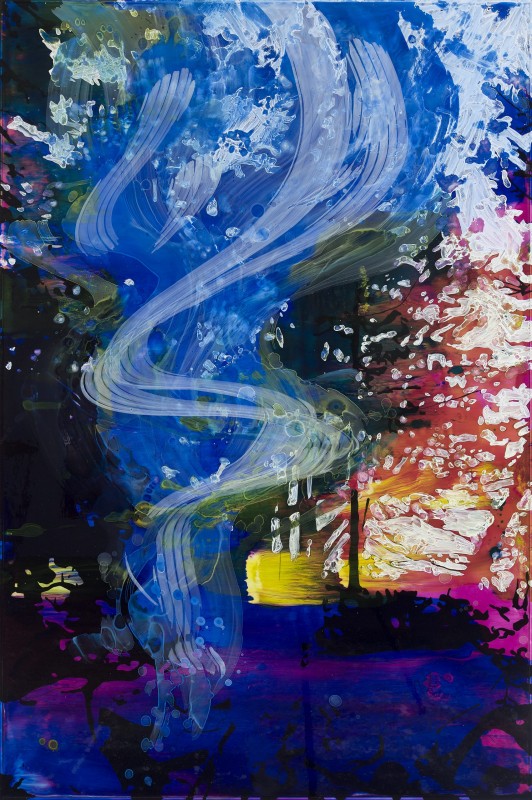 Steve Driscoll, “Smoke Show (Setting Sun)”, 2014. Urethane on board, 60″ x 40″. Photo: Courtesy of Angell Gallery
Steve Driscoll, “Smoke Show (Setting Sun)”, 2014. Urethane on board, 60″ x 40″. Photo: Courtesy of Angell Gallery
The six paintings in Smoke Show depict the stages of campfire and smoke through the changing hours from daylight, through dusk and darkness, till dawn — creating a series like Monet’s “Haystacks”. Fire and smoke have been filled with mythological and mystical meaning throughout human history and have always been used in ceremonies as well as in everyday life. The smoke itself can be a signal for help or it can betray your whereabouts. Smoke was believed to scare away evil, and clear and bless your place. It is also a symbol of memories, the passing of time, and love or happiness flowing away. In Driscoll’s paintings, smoke becomes the main character in nature’s theatre. It is the same scene for each painting: a small clearing in front of some trees. In the canvases, grey towers of smoke that over-spill the burning fire, dance, flirt and frolic in the air. Each painting creates a different feeling with depicting the atmosphere of the passing hours by changing colors. “Setting Sun” and “Trance” captures the last golden rays of the sun surrounded by the approaching darkness. Then the witching hour (“Magic Hour”) and dusk (“Dusk”) come and darkness takes over. The colors of the landscape deepen into dark blues, magentas and purples, until black covers most of the surface. As the landscapes darken, the smoke becomes more dramatic filling the whole foreground. It sparkles with white light and ashes fly like fireflies or snowflakes. In “Only Come to Leave” the fire is still there but the empty blue bench on the right and the mostly cold blue palette suggest that it is already morning and time to leave. The painting covers a larger area of the clearing but the magic of the smoke is gone.
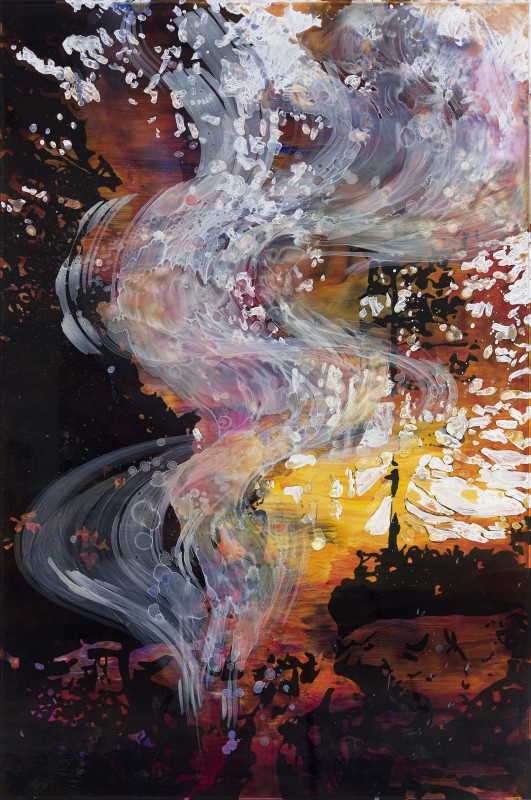 Steve Driscoll, “Smoke Show (Trance)”, 2014. Urethane on board, 60″ x 40″. Photo: Courtesy of Angell Gallery
Steve Driscoll, “Smoke Show (Trance)”, 2014. Urethane on board, 60″ x 40″. Photo: Courtesy of Angell Gallery
Looking at the paintings I feel melancholy and strangely place myself behind the fire, just in front of the trees. I know that’s not the right place since, as the viewer, I should be on the other side of the fire, looking at the landscape through the smoke. The smoke embraces me but at the same time I still feel the hold of the tawny tree roots on me and the call of the forest, but the smoke has a mesmerizing power with its magical playfulness that dims my mind. It has many possible interpretations as in Henry David Thoreau’s poem Smoke “Light-winged Smoke, Icarian bird, / Melting thy pinions in thy upward flight, …/ Or else, departing dream, and shadowy form / Of midnight vision…”
Steve Driscoll loves nature and spends lots of time in the wilderness, hiking and kayaking, regardless of the weather. He always takes his camera with him and takes countless photographs that he later uses for his paintings. In those paintings, however, he doesn’t stick to the real landscape but often mixes elements, using the lake from one image, the forest from another and then adds his often weird light effects – creating his unique visions.
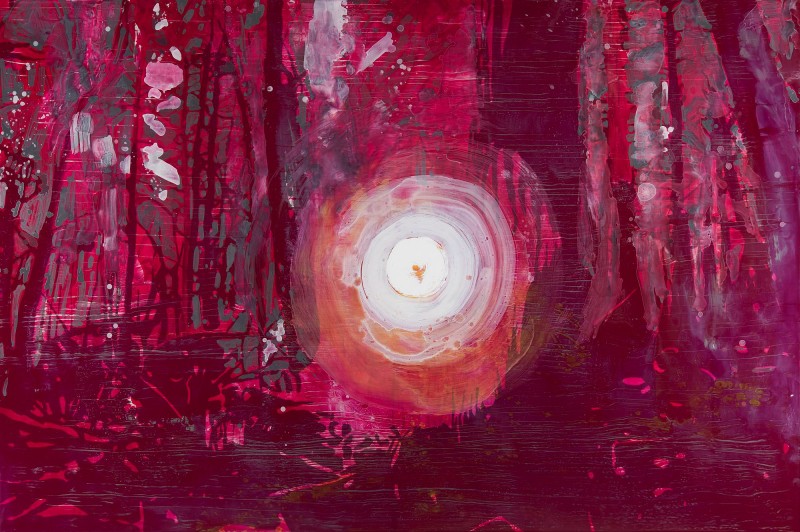 Steve Driscoll, “Warmth We Once Knew”. Urethane on panel, 60″ x 90″. Photo: Courtesy of Angell Gallery
Steve Driscoll, “Warmth We Once Knew”. Urethane on panel, 60″ x 90″. Photo: Courtesy of Angell Gallery
“The Warmth We Once Knew” contains different hues of only one color, purple, with white added for the light. I call it a purple orgy, since it is such a strong and vibrant piece. Even though it is a symmetrical composition — the sun being in the center — it is still very unsettling since it is hard to decide where the waterline is and where the real land ends and the mirror image starts. It is more abstract than realistic as the land transcends into something unworldly through this burning purple. The way the sun is depicted reminds me of the intensity of Van Gogh’s vision in “Starry Night.” As Driscoll remembered, the idea came from an early spring fishing trip when there are no leaves on the trees, and the sun sets right through the forest. “In wonder, I often find myself staring at this low burning flame. Being on the horizon you can hold your gaze for longer than normal. The resulting image after closing your eyes is what this piece was attempting to depict — the vision burned into your eyelids.” The painting is immensely physical, pulsating with a toxic purple that almost hurts your retina.
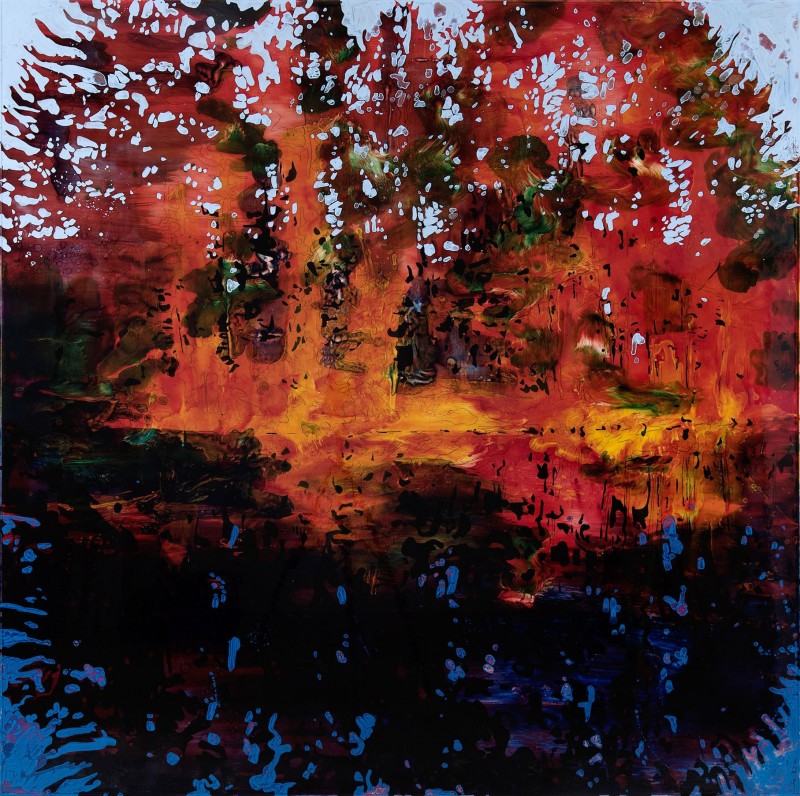 Steve Driscoll, “Fall is a Feeling You Just Can’t Lose”,2014. Urethane on panel, 78″ x 78″. Photo: Courtesy of Angell Gallery
Steve Driscoll, “Fall is a Feeling You Just Can’t Lose”,2014. Urethane on panel, 78″ x 78″. Photo: Courtesy of Angell Gallery
“Fall is a Feeling You Just Can’t Lose” is a painting you just can’t walk by. It mesmerizes you with its strong oranges and reds contrasted by deep blues. It is a fall landscape with the forest at its most colorful and the setting sun lighting up the trees so strongly that it is almost unbearable and at the same time you want to lose yourself in it. In “Portage”, another strongly colored piece, the purple road seems to guide us into the unknown, into the hidden eternity of the forest. It is, however, a depiction of the end of a portage, which by nature, Driscoll thinks, is the most exciting part of any portage. “The anticipation of relief is usually the only thing carrying the body forward at that point. The opening of the canopy is the first sign of the impending lake ahead, followed by snippets of reflecting water at a distance. Portage embodies that feeling of excitement and relief in one.” The vertical line in the centre of the piece is a loosely rendered section of trail boardwalk consisting of fallen logs, a common sight in boggy sections of a well-used trail. Even after all the details are explained, the painting still contains a magical power and “captures the spirit of the place with a fresh vision”, as every article about Driscoll states. In these paintings juxtaposing loud colors I still feel the peaceful presence of nature as in an old Native American elder story:
“Stand still.
The trees ahead and the bushes beside you Are not lost.
Wherever you are is called Here,
And you must treat it as a powerful stranger,
Must ask permission to know it and be known.
The forest breathes. Listen. It answers…”
(rendered into modern English by David Wagoner, in The Heart Aroused: Poetry and the Preservation of the Soul in Corporate America by David Whyte, Currency Doubleday, New York, 1996.)
 Steve Driscoll, “Portage”, 2014. Urethane on board, 78″ x 78″. Photo: Courtesy of Angell Gallery
Steve Driscoll, “Portage”, 2014. Urethane on board, 78″ x 78″. Photo: Courtesy of Angell Gallery
One might say that Driscoll’s colors are all artificial. That may be true but they are still deeply rooted in nature. While still living in Europe, I was looking at books of Canadian landscapes and seeing all the burning reds and golden yellows I thought that those printing companies had done a poor job and all those colors must be over exaggerated. Living on the lakeside in Toronto and walking in nature for more than 25 years now, I have to apologize. The sand can be purple in a cold sunset — or gold. The color of the lake involves all the possible blues and grays, plus many colors without names and the trees really are golden and bright red. The sky is amazing and bleeds heavily or shines in silver. This is a colourful place, a painter’s paradise. Beauty is in the eye of the beholder, our perceptions are different. Photoshop images surround us in advertisements. Movies and “documentary” travel videos are “touched up.” What is true and what is false? I would consider John Keats’ lines from “Ode on a Grecian Urn” that, “Beauty is truth, truth beauty” in describing Driscoll’s paintings. What we see on the canvases is his persona, his painterly truth and it is beautiful. In his latest email to me he wrote, “I hope that my work can inspire a sense of wonder in the viewer. I experience great joy in producing it.” I think it certainly does – both – wonder and joy.
Emese Krunák-Hajagos
*Exhibition information: The Smoke Show and Other Deceptions in Paint, January 9 – February 15, 2015, Angell Gallery, 12 Ossington Avenue, Toronto. Gallery hours: Wed – Sat, 12 – 5 p.m.

I have a large collection of Steve’s work from different times and I enjoy getting lost in the landscapes and waves. I’ glad for now I don’t have a spot for “Warmth We Once Knew” in my living room. Thanks for this piece it was nice to read up a little more.